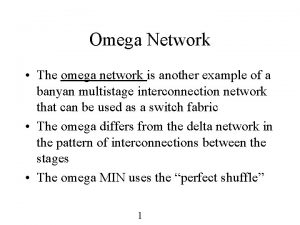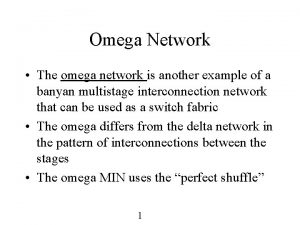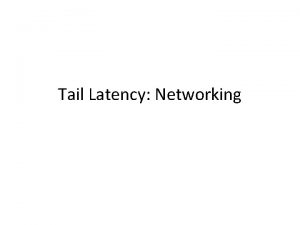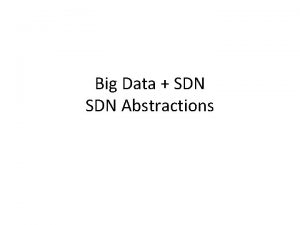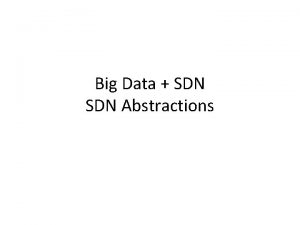Network Sharing The story thus far Sharing Omega








































![Rate Allocation – Adaptive Algorithm � Use � Seawall [NSDI’ 11] as rate-allocation algorithm Rate Allocation – Adaptive Algorithm � Use � Seawall [NSDI’ 11] as rate-allocation algorithm](https://slidetodoc.com/presentation_image_h2/37a300addc1c433ea87e7e34137d50a0/image-41.jpg)
![Rate Allocation – Adaptive Algorithm � Use � Seawall [NSDI’ 11] as rate-allocation algorithm Rate Allocation – Adaptive Algorithm � Use � Seawall [NSDI’ 11] as rate-allocation algorithm](https://slidetodoc.com/presentation_image_h2/37a300addc1c433ea87e7e34137d50a0/image-42.jpg)














- Slides: 56

Network Sharing

The story thus far: Sharing � Omega � + Mesos How to share End-host resource � Think � CPU, Memory, I/O Different ways to share: � Fair sharing: Idealist view. Everyone should get equal access � Proportional sharing: Ideal for public cloud Get access to an amount equal to how much you pay � Priority-Deadline � What � based sharing: Ideal for private data center. Company care about completion times. about the network? Isn’t this important?

Network Caring is Network Sharing � Network � Default � Vague is import to a jobs completion time. network sharing is TCP notion of fair sharing � Fairness is based on individual flows � Work-conserving � Per-Flow � VMs based sharing is biased with many flows get a greater share of the network

What is the best form of Network Sharing � Fair sharing: � Per-Source � Reducers based fairness? cheats– many flows to one destination. � Per-Destination � Map based fairness? can cheat � Fairness === Bad: � No one can predict anything. � And we like things to be prediction: we like short and predictable latency � Min-Bandwidth � Perfect!! Guarantees But: � Implementation can lead to inefficiency � How do you predict bandwidth demands

What is the best form of Network Sharing � Fair sharing: � Per-Source � Reducers based fairness? cheats– many flows to one destination. � Per-Destination � Map based fairness? can cheat � Fairness === Bad: � No one can predict anything. � And we like things to be prediction: we like short and predictable latency � Min-Bandwidth � Perfect!! Guarantees But: � Implementation can lead to inefficiency � How do you predict bandwidth demands

What is the best form of Network Sharing � Fair sharing: � Per-Source � Reducers based fairness? cheats– many flows to one destination. � Per-Destination � Map based fairness? can cheat � Fairness === Bad: � No one can predict anything. � And we like things to be prediction: we like short and predictable latency � Min-Bandwidth � Perfect!! Guarantees But: � Implementation can lead to inefficiency � How do you predict bandwidth demands

How can you share the network? � Endhost sharing schemes � Use default TCP? Never! � Change the hypervisor! � Requires � Change the endhost’s TCP stack � Invasive and undesirably � In-Network � Use virtualization sharing schemes queues and rate-limiters � Limited � Utilize enforcing to 7 -8 different guarantees ECN � Requires � Other switches that support ECN mechanism switch modifications � Expensive and highly unlikely except maybe Open. Flow.

Elastic. Switch: Practical Work-Conserving Bandwidth Guarantees for Cloud Computing Lucian Popa Praveen Yalagandula* Sujata Banerjee Jeffrey C. Mogul+ Yoshio Turner Jose Renato Santos HP Labs * Avi Networks + Google

Goals 1. Provide Minimum Bandwidth Guarantees in Clouds � Tenants � � can affect each other’s traffic Map. Reduce jobs can affect performance of user-facing applications Large Map. Reduce jobs can delay the completion of small jobs � Bandwidth guarantees offer predictable performance

Goals 1. Provide Minimum Bandwidth Guarantees in Clouds Hose model Virtual (imaginary) Switch VS BX X BY Y BZ Bandwidth Guarantees Z VMs of one tenant Other models based on hose model such as TAG [Hot. Cloud’ 13]

Goals 1. 2. Provide Minimum Bandwidth Guarantees in Clouds Work-Conserving Allocation � Tenants can use spare bandwidth from unallocated or underutilized guarantees

Goals 1. 2. Provide Minimum Bandwidth Guarantees in Clouds Work-Conserving Allocation � Tenants can use spare bandwidth from unallocated or underutilized guarantees � Significantly increases performance � Average traffic is low [IMC 09, IMC 10] � Traffic is bursty

Goals 2. Provide Minimum Bandwidth Guarantees in Clouds Work-Conserving Allocation Elastic. Switc h Bmin X Bmin Y X Y bandwidth 1. Everything reserved & use Free capacity Bmin Time

Goals 1. 2. 3. Provide Minimum Bandwidth Guarantees in Clouds Work-Conserving Allocation Be Practical � � � Topology independent: work with oversubscribed topologies Inexpensive: per VM/per tenant queues are expensive work with commodity switches Scalable: centralized controller can be bottleneck distributed solution � Hard to partition: VMs can cause bottlenecks anywhere in the network

Goals 1. 2. 3. Provide Minimum Bandwidth Guarantees in Clouds Work-Conserving Allocation Be Practical

Prior Work Guarantees Workconserving Practical X (fair sharing) √ √ Second. Net [Co. NEXT’ 10] √ X √ Oktopus [SIGCOMM’ 10] √ X ~X (centralized) Gatekeeper [WIOV’ 11], Eye. Q [NSDI’ 13] √ √ X (congestion-free core) Fair. Cloud (PS-P) [SIGCOMM’ 12] √ √ X (queue/VM) Hadrian [NSDI’ 13] √ √ X (weighted RCP) Elastic. Switch √ √ √ Seawall [NDSI’ 11], Net. Share [TR], Fair. Cloud (PS-L/N) [SIGCOMM’ 12]

Outline � Motivation and Goals � Overview � More Details � Guarantee Partitioning � Rate Allocation � Evaluation

Elastic. Switch Overview: Operates At Runtime Tenant selects bandwidth guarantees. Models: Hose, TAG, etc. Oktopus [SIGCOMM’ 10] Hadrian [NSDI’ 10] Cloud. Mirror [Hot. CLoud’ 13] Elastic. Switc h VMs placed, Admission Control ensures all guarantees can be met VM setup Enforce bandwidth guarantees & Provide work-conservation Runtime

Elastic. Switch Overview: Runs In Hypervisors • Resides in the hypervisor of each host • Distributed: Communicates pairwise following data flows VM Hypervisor VM VM Elastic. Swit ch Network VM Hypervisor VM Elastic. Swit ch VM Hypervisor Elastic. Swit ch

Elastic. Switch Overview: Two Layers Guarantee Partitioning Rate Allocation Hypervisor Provides Guarantees Provides Work-conservation

Elastic. Switch Overview: Guarantee Partitioning 1. Guarantee Partitioning: turns hose model into VM-to-VM pipe guarantees VM-to-VM control is necessary, coarser granularity is not enough

Elastic. Switch Overview: Guarantee Partitioning 1. Guarantee Partitioning: turns hose model into VM-to-VM pipe guarantees VS Intra-tenant BX X BY Z Y BX Y BZ BX Z VM-to-VM guarantees bandwidths as if tenant communicates on a physical hose network

Elastic. Switch Overview: Rate Allocation 1. Guarantee Partitioning: turns hose model into VM-to-VM pipe guarantees 2. Rate Allocation: uses rate limiters, increases rate between X-Y above BX Y when there is no congestion between X and Y VS Work-conserving allocation Inter-tenant BX X X Hypervisor Rate. X Y BY Y BZ Z ≥ BX Y Limiter Y Hypervisor Unreserved/Unused Capacity

Elastic. Switch Overview: Periodic Application Guarantee Partitioning VM-to-VM guarantees Rate Allocation Hypervisor Applied periodically and on new VM-to-VM pairs Demand estimates Applied periodically, more often

Outline � Motivation and Goals � Overview � More Details � Guarantee Partitioning � Rate Allocation � Evaluation

Guarantee Partitioning – Overview VS 1 BX X Y Z BQ T Q Z T B X Z B X Y Max-min X allocation Goals: A. Safety – don’t violate hose model B. Efficiency – don’t waste guarantee C. No Starvation – don’t block traffic B T Y Y B Q Y Q

Guarantee Partitioning – Overview VS 1 BX X Y Z BQ T Q BX = … = BQ = 100 Mbps Z T 33 Mbps 66 Mbps 33 Mbps Max-min X allocation Goals: A. Safety – don’t violate hose model B. Efficiency – don’t waste guarantee C. No Starvation – don’t block traffic Y 33 Mbps Q

Guarantee Partitioning – Operation VS 1 BX X Y Z BQ T Q Z X Z T T Y BY X Y BX BX Y = min( BX , BY ) X X Y Y X Y BX BY Q Y Hypervisor divides guarantee of each BY hosted VM between VM-to-VM pairs in Q each direction Source hypervisor uses the minimum between the source and destination guarantees

Guarantee Partitioning – Safety VS 1 BX X Y Z BQ T Q Z T X Z X Y BX BX Y = min( BX , BY ) X X Y BX BY Safety: hose-model guarantees are not exceeded Q T Y BY Y Q Y BY

Guarantee Partitioning – Operation VS 1 BX X Y Z BQ T Q Z BX = … = BQ = 100 Mbps X BX Y = T X Y min( BX , X Y BY Q ) Y

Guarantee Partitioning – Operation VS 1 BX X Y Z BX Y = BQ T Q BX = … = BQ = 100 Mbps X Y min( BX Z BX = X 50 X Y BX = 50 , X Y BY ) T T Y BY = BX Y = 33 X Y BY = Q Y 33 33 Q Y BY = 33

Guarantee Partitioning – Efficiency VS 1 BX X Z Y BQ T Q BX = … = BQ = 100 Mbps Z X Z BX = X 50 T T Y BY = BX Y = 33 X Y BX = 50 X Y BY = 33 Q Hypervisor divides guarantees max-min based on demands (future demands estimated based on history) 1 What happens when flows have low demands? Y 33

Guarantee Partitioning – Efficiency VS 1 BX X Z Y BQ T Q BX = … = BQ = 100 Mbps Z X Z BX = X 66 50 T T Y BY = BX Y = 33 X Y BX = 5033 1 What happens when flows have low demands? 2 How to avoid unallocated guarantees? X Y BY = Q Y 33 33 Q Y BY = 33

Guarantee Partitioning – Efficiency VS 1 BX X Y Z BQ T Q BX = … = BQ = 100 Mbps Z X Z BX = X 66 50 T T Y BY = BX Y = 33 X Y BX = 5033 Source considers destination’s allocation when destination is bottleneck Guarantee Partitioning converges X Y BY = Q Y 33 33 Q Y BY = 33

Outline � Motivation and Goals � Overview � More Details � Guarantee Partitioning � Rate Allocation � Evaluation

Rate Allocation RX Y Spare bandwidth Fully used X Guarantee Partitioning BX Y Time Congestion data Rate Allocation Rate RX Y Limiter Y

Rate Allocation RX Y = max(BX Y , RTCP-like) X Guarantee Partitioning BX Y Congestion data Rate Allocation Rate RX Y Limiter Y

Rate Allocation RX Y = max(BX Y , RTCP-like) Rate Limiter Rate 1000 Another Tenant 900 800 Mbps 700 600 500 400 300 Guarantee 200 100 0 144, 18 144, 68 145, 18 145, 68 146, 18 146, 68 Seconds 147, 18 147, 68 148, 18

Rate Allocation RX Y = max(BX Y , Rweighted-TCP-like) Weight is the BX Y guarantee X Z RX Y = 333 Mbps BX Y = 100 Mbps RX T = 666 Mbps BZ T = 200 Mbps L = 1 Gbps Y T

Rate Allocation – Congestion Detection � Detect congestion through dropped packets � Hypervisors add/monitor sequence numbers in packet headers � Use ECN, if available
![Rate Allocation Adaptive Algorithm Use Seawall NSDI 11 as rateallocation algorithm Rate Allocation – Adaptive Algorithm � Use � Seawall [NSDI’ 11] as rate-allocation algorithm](https://slidetodoc.com/presentation_image_h2/37a300addc1c433ea87e7e34137d50a0/image-41.jpg)
Rate Allocation – Adaptive Algorithm � Use � Seawall [NSDI’ 11] as rate-allocation algorithm TCP-Cubic like � Essential improvements (for when using dropped packets) Many flows probing for spare bandwidth affect guarantees of others
![Rate Allocation Adaptive Algorithm Use Seawall NSDI 11 as rateallocation algorithm Rate Allocation – Adaptive Algorithm � Use � Seawall [NSDI’ 11] as rate-allocation algorithm](https://slidetodoc.com/presentation_image_h2/37a300addc1c433ea87e7e34137d50a0/image-42.jpg)
Rate Allocation – Adaptive Algorithm � Use � Seawall [NSDI’ 11] as rate-allocation algorithm TCP-Cubic like � Essential improvements (for when using dropped packets) � Hold-increase: hold probing for free bandwidth after a congestion event. Holding time is inversely proportional to guarantee. Rate increasing Guarantee Holding time

Outline � Motivation and Goals � Overview � More Details � Guarantee Partitioning � Rate Allocation � Evaluation

Evaluation – Map. Reduce � Setup � 44 servers, 4 x oversubscribed topology, 4 VMs/server � Each tenant runs one job, all VMs of all tenants same guarantee � Two scenarios: � Light � 10% of VM slots are either a mapper or a reducer � Randomly placed � Heavy � 100% of VM slots are either a mapper or a reducer � Mappers are placed in one half of the datacenter

CDF Evaluation – Map. Reduce Worst case shuffle completion time / static reservation

Evaluation – Map. Reduce Elastic. Switch No Protection Longest completion reduced from No Protection CDF Work-conserving pays off: finish faster than static reservation Light Setup Worst case shuffle completion time / static reservation

Evaluation – Map. Reduce Elastic. Switch enforces guarantees in worst case No Protection CDF up to 160 X Guarantees are useful in reducing worst-case shuffle completion Heavy Setup Worst case shuffle completion time / static reservation

Elastic. Switch Summary � Properties 1. 2. 3. Bandwidth Guarantees: hose model or derivatives Work-conserving Practical: oversubscribed topologies, commodity switches, decentralized � Design: two layers � Guarantee Partitioning: provides guarantees by transforming hose-model guarantees into VM-to-VM guarantees � Rate Allocation: enables work conservation by increasing rate limits above guarantees when no congestion HP Labs is hiring!

Future Work � Reduce Overhead � Elastic. Switch: average 1 core / 15 VMs , worst case 1 core /VM � Multi-path solution � Single-path reservations are inefficient � No existing solution works on multi-path networks � VM placement � Placing VMs in different locations impacts the gaurantees that can be made.

Open Questions � How do you integrate network sharing with endhost sharing. � What are the implications of different sharing mechanisms with each other? � How does the network architecture affect network sharing? � How do you do admission control? � How do you detect demand? � How does payment fit into this question? And if it does, when VMs from different people communicate, who dictates price, who gets charged?

Elastic Switch – Detecting Demand � Optimize for bimodal distribution flows � Most flows short, a few flows carry most bytes � Short flows care about latency, long flows care about throughput � Start � If with a small guarantee for a new VM-to-VM flow demand not satisfied, increase guarantee exponentially

Perfect Network Architecture � What happens in the perfect network architecture? � Implications: � No loss in network � Only at the edge of the network: � Edge uplinks between Server and To. R � Or hypervisor to VM – virtual links � These � VL 2 losses core networks are real: at Azure � Clos at Google

Open Questions � How do you integrate network sharing with endhost sharing. � What are the implications of different sharing mechanisms with each other? � How does the network architecture affect network sharing? � How do you do admission control? does payment fit into this question? And if it does, when VMs from different people communicate, who dictates price, who gets charged?

Open Questions � How do you integrate network sharing with endhost sharing. � What are the implications of different sharing mechanisms with each other? � How does the network architecture affect network sharing? � How do you do admission control? does payment fit into this question? And if it does, when VMs from different people communicate, who dictates price, who gets charged?

Open Questions � How do you integrate network sharing with endhost sharing. � What are the implications of different sharing mechanisms with each other? � How does the network architecture affect network sharing? � How do you do admission control? does payment fit into this question? And if it does, when VMs from different people communicate, who dictates price, who gets charged?

 Macbeth quotes banquo
Macbeth quotes banquo Araşidonik asit metabolizması
Araşidonik asit metabolizması Esansiyel yağ asitleri nelerdir
Esansiyel yağ asitleri nelerdir Wear skins peeped through by bones figure of speech
Wear skins peeped through by bones figure of speech What does shakespeare head symbolises
What does shakespeare head symbolises In a kingdom far far away
In a kingdom far far away Far far away city
Far far away city Let's discuss the story so far
Let's discuss the story so far Network sharing
Network sharing Hence vs thus
Hence vs thus Hence vs thus
Hence vs thus When to use hence and thus
When to use hence and thus O my good lord why are you thus alone
O my good lord why are you thus alone Moment of couple formula
Moment of couple formula The three metamorphoses
The three metamorphoses Nine times the space that measures day and night
Nine times the space that measures day and night Hình ảnh bộ gõ cơ thể búng tay
Hình ảnh bộ gõ cơ thể búng tay Lp html
Lp html Bổ thể
Bổ thể Tỉ lệ cơ thể trẻ em
Tỉ lệ cơ thể trẻ em Chó sói
Chó sói Tư thế worm breton
Tư thế worm breton Hát lên người ơi alleluia
Hát lên người ơi alleluia Kể tên các môn thể thao
Kể tên các môn thể thao Thế nào là hệ số cao nhất
Thế nào là hệ số cao nhất Các châu lục và đại dương trên thế giới
Các châu lục và đại dương trên thế giới Công của trọng lực
Công của trọng lực Trời xanh đây là của chúng ta thể thơ
Trời xanh đây là của chúng ta thể thơ Mật thư anh em như thể tay chân
Mật thư anh em như thể tay chân Phép trừ bù
Phép trừ bù Phản ứng thế ankan
Phản ứng thế ankan Các châu lục và đại dương trên thế giới
Các châu lục và đại dương trên thế giới Thơ thất ngôn tứ tuyệt đường luật
Thơ thất ngôn tứ tuyệt đường luật Quá trình desamine hóa có thể tạo ra
Quá trình desamine hóa có thể tạo ra Một số thể thơ truyền thống
Một số thể thơ truyền thống Bàn tay mà dây bẩn
Bàn tay mà dây bẩn Vẽ hình chiếu vuông góc của vật thể sau
Vẽ hình chiếu vuông góc của vật thể sau Nguyên nhân của sự mỏi cơ sinh 8
Nguyên nhân của sự mỏi cơ sinh 8 đặc điểm cơ thể của người tối cổ
đặc điểm cơ thể của người tối cổ Thứ tự các dấu thăng giáng ở hóa biểu
Thứ tự các dấu thăng giáng ở hóa biểu Vẽ hình chiếu đứng bằng cạnh của vật thể
Vẽ hình chiếu đứng bằng cạnh của vật thể Phối cảnh
Phối cảnh Thẻ vin
Thẻ vin đại từ thay thế
đại từ thay thế điện thế nghỉ
điện thế nghỉ Tư thế ngồi viết
Tư thế ngồi viết Diễn thế sinh thái là
Diễn thế sinh thái là Dot
Dot So nguyen to
So nguyen to Tư thế ngồi viết
Tư thế ngồi viết Lời thề hippocrates
Lời thề hippocrates Thiếu nhi thế giới liên hoan
Thiếu nhi thế giới liên hoan ưu thế lai là gì
ưu thế lai là gì Khi nào hổ mẹ dạy hổ con săn mồi
Khi nào hổ mẹ dạy hổ con săn mồi Sự nuôi và dạy con của hươu
Sự nuôi và dạy con của hươu Sơ đồ cơ thể người
Sơ đồ cơ thể người Từ ngữ thể hiện lòng nhân hậu
Từ ngữ thể hiện lòng nhân hậu



























































